Key takeaways:
- Defining clear objectives at the outset of a security audit is crucial for directing focus and efficiency.
- Meticulous documentation and collaboration across departments enhance the audit process and uncover hidden risks.
- Engaging various stakeholders during risk assessments leads to deeper insights and actionable strategies for improvement.
- Creating structured action plans with measurable outcomes fosters accountability and tracks progress effectively post-audit.
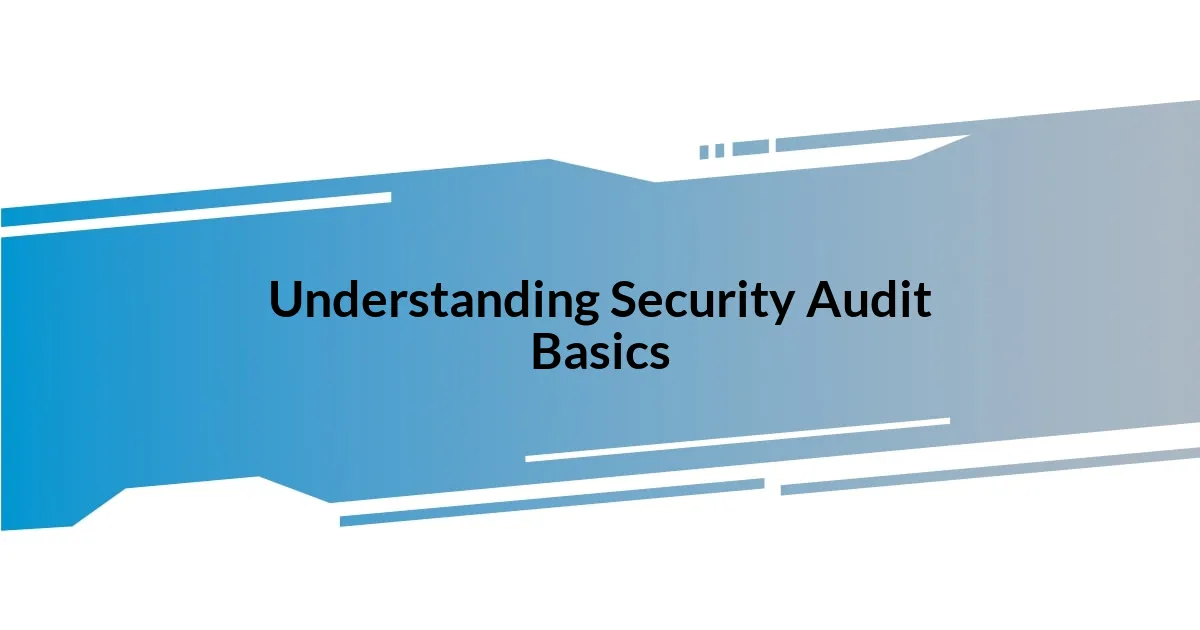
Understanding Security Audit Basics
A security audit is essentially a systematic examination of an organization’s information system, highlighting vulnerabilities and compliance with security policies. I recall my first audit, where I was both excited and anxious. I wondered, “Could I catch all the potential risks?” That moment of realization that thorough preparation is key truly stuck with me.
When I think about security audits, I can’t help but reflect on the importance of defining clear objectives. Are we assessing for regulatory compliance, or are we seeking to identify operational security weaknesses? This distinction can impact the entire audit process. Asking the right questions upfront can save teams from diving into irrelevant details—something I learned the hard way during a rushed audit.
The process typically includes reviewing documentation, scanning for security flaws, and interviewing staff members. I remember feeling a bit intimidated when meeting with IT teams for the first time, but I quickly discovered how insightful their firsthand experiences could be. Engaging with them not only opened my eyes to hidden risks but also fostered a collaborative atmosphere that made everyone feel invested in the audit’s outcome.
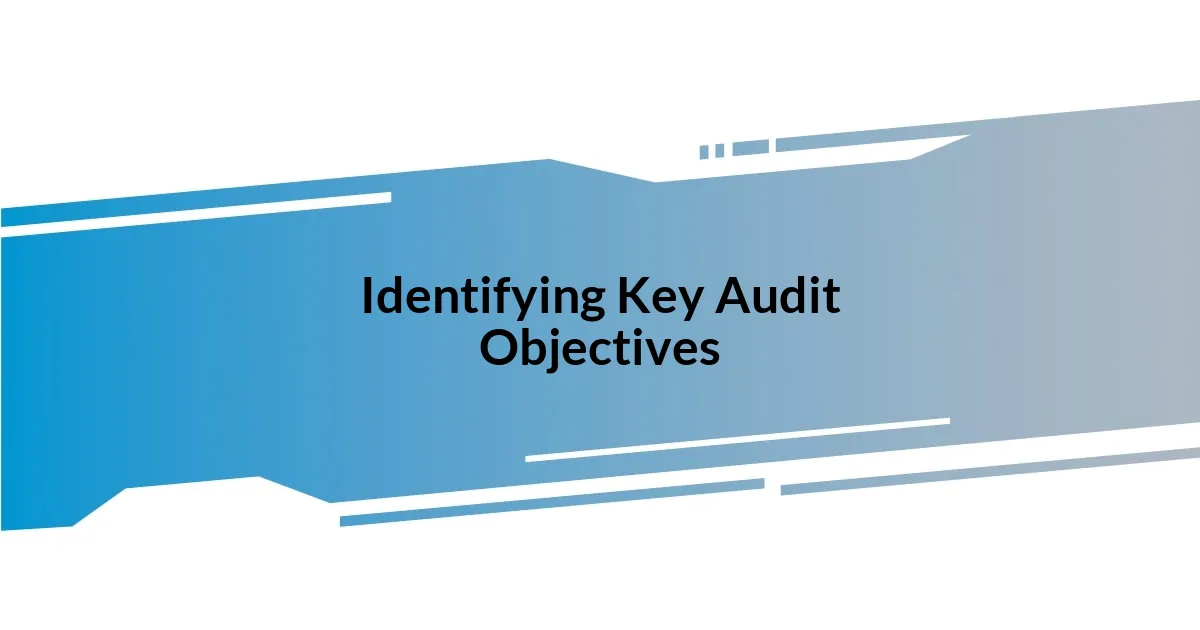
Identifying Key Audit Objectives
Identifying key audit objectives is a crucial step that often shapes the trajectory of the entire security audit. From my experience, taking the time to pinpoint precise objectives not only streamlines the audit process but also ensures that the audit team’s efforts are focused and effective. For instance, I once spent hours sifting through irrelevant data in an attempt to meet overly broad objectives, only to realize that defining our goals more narrowly would have saved time and provided better insights.
Here are some critical objectives to consider when planning your security audit:
- Regulatory Compliance: Ensure alignment with laws and regulations relevant to your industry.
- Risk Management: Identify and evaluate potential security risks that could impact the organization.
- Operational Efficiency: Assess how security measures can be improved for better operational performance.
- Incident Response Readiness: Evaluate the organization’s ability to respond to security incidents effectively.
- Stakeholder Assurance: Provide confidence to stakeholders that security practices are sound and effective.
When I take a moment to reflect on past audits, I can’t help but smile at the evolution of my approach. Developing clear objectives felt daunting at first, but it became one of the most rewarding aspects of the process. It transformed my audit journeys into focused missions rather than chaotic quests, fostering a sense of accomplishment that I cherish today.
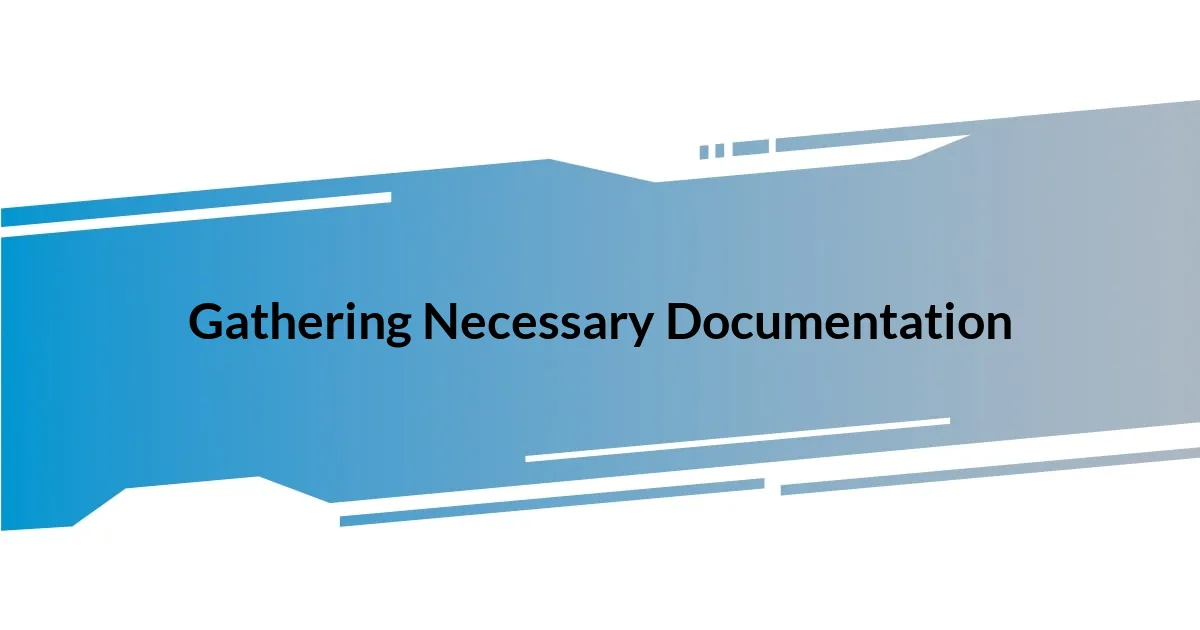
Gathering Necessary Documentation
When it comes to gathering necessary documentation for a security audit, meticulous preparation is essential. I’ve learned that having detailed and organized documentation can make a significant difference in the efficiency of the audit process. For instance, during one audit, I discovered that a comprehensive list of assets and their configurations allowed the team to identify potential vulnerabilities quickly. Without that critical information, we would have spent precious time scrambling for the right data.
I can’t stress enough the importance of including various types of documentation. This can range from security policies and network diagrams to previous audit reports and incident response plans. I remember a project where we overlooked the importance of reviewing past incidents, which ultimately left us vulnerable to repetitive mistakes. Including this documentation helped us not only address existing flaws but also build a robust framework for future audits.
In my experience, a systematic approach to gathering documentation pays off. Engaging with different departments can yield insights you might not expect. For instance, I once sat down with the HR team to review access controls. What I uncovered during that meeting was a treasure trove of information that enriched our audit significantly. Collaboration truly does elevate the auditing process.
| Type of Documentation | Purpose |
|---|---|
| Security Policies | Baseline security expectations and procedures. |
| Network Diagrams | Visual representation of the network architecture. |
| Incident Response Plans | Preparedness for addressing potential security breaches. |
| Past Audit Reports | Insights into previously identified vulnerabilities and resolutions. |
| Access Control Lists | Details on user permissions and privileges. |
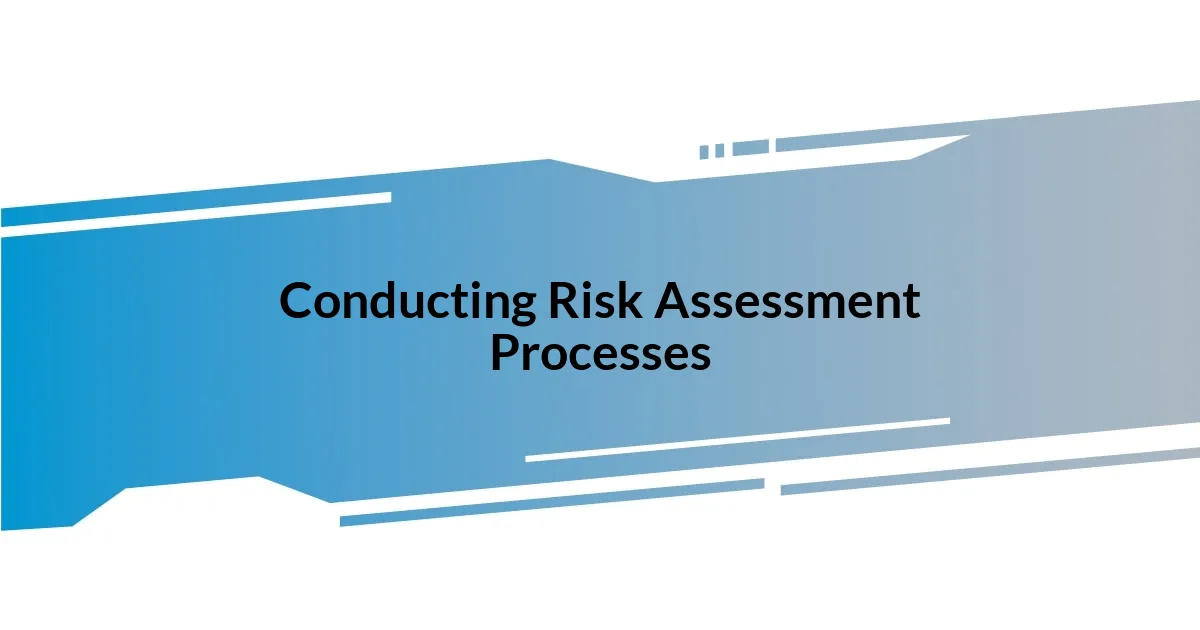
Conducting Risk Assessment Processes
Conducting risk assessment processes is vital to understanding and mitigating potential vulnerabilities within an organization. I recall a time when my team and I huddled over a whiteboard, brainstorming what risks posed the highest threat to our operations. It was an eye-opening experience, highlighting not only our weaknesses but also areas we had previously overlooked. By categorizing risks into levels of severity, we created a clear roadmap to prioritize our actions. It was thrilling to watch our collective insights translate into a targeted strategy that genuinely fortified our defenses.
One key aspect of risk assessment is engaging people from different departments. I often ask, “Who knows the system better than the users themselves?” This collaborative approach uncovers unique perspectives, and I remember a valuable lesson I learned during a risk assessment meeting with the IT team—they identified peculiar software that, at first glance, seemed harmless but was actually an entry point for potential threats. Their input not only enriched the assessment but also reinforced my belief in teamwork’s power.
In my experience, documenting identified risks is just as crucial as recognizing them. When we compiled a risk registry, complete with potential impacts and mitigation strategies, it felt like giving our organization a new pair of glasses—everything became clearer. Reflecting on that moment, I found it incredibly satisfying to present our findings to leadership, knowing we provided them with actionable insights. Is there a better feeling than empowering others to make informed decisions based on your recommendations? That’s the essence of a successful risk assessment process.
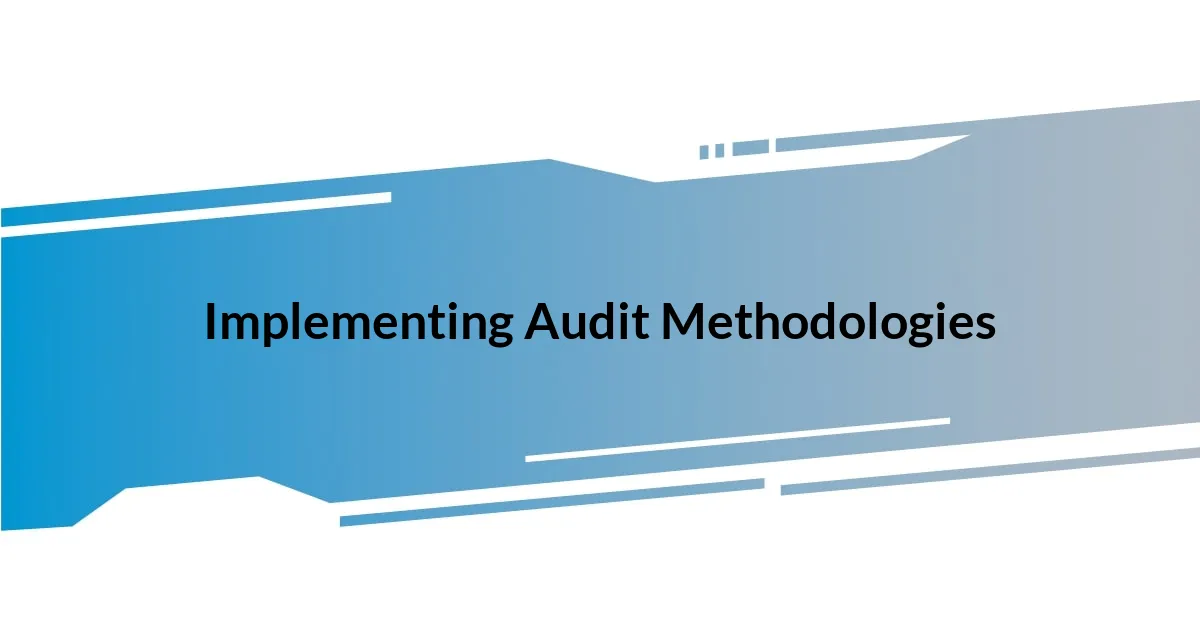
Implementing Audit Methodologies
Implementing effective audit methodologies requires a blend of tailored strategies and adaptable frameworks. I once led a security audit where we opted for a risk-based approach, prioritizing assets based on their criticality to the business operations. This adjustment not only streamlined our efforts but also focused our attention on areas that posed the greatest risk. Don’t you think it’s empowering to concentrate resources where they count the most?
Adopting a checklist-driven methodology can also enhance consistency across audits. During one project, we devised a comprehensive checklist that measured compliance against key security controls. I vividly recall how, on reviewing the completed checklist, we uncovered a significant oversight regarding data encryption protocols. It was a moment of realization for the whole team—reinforcing how checklists can become our allies in documenting compliance findings and ensuring they aren’t overlooked.
Moreover, I believe in the value of embracing continuous improvement through iterative feedback. After each audit, I encourage debriefing sessions to discuss what went well and where we can enhance our methods. “How can we refine our approach for the next time?” is a question I often pose. In one memorable session, we identified communication gaps that hindered our efficiency; addressing that truly transformed our audit processes, leading to richer insights in subsequent evaluations. Isn’t it remarkable how learning from our experiences can elevate our expertise?
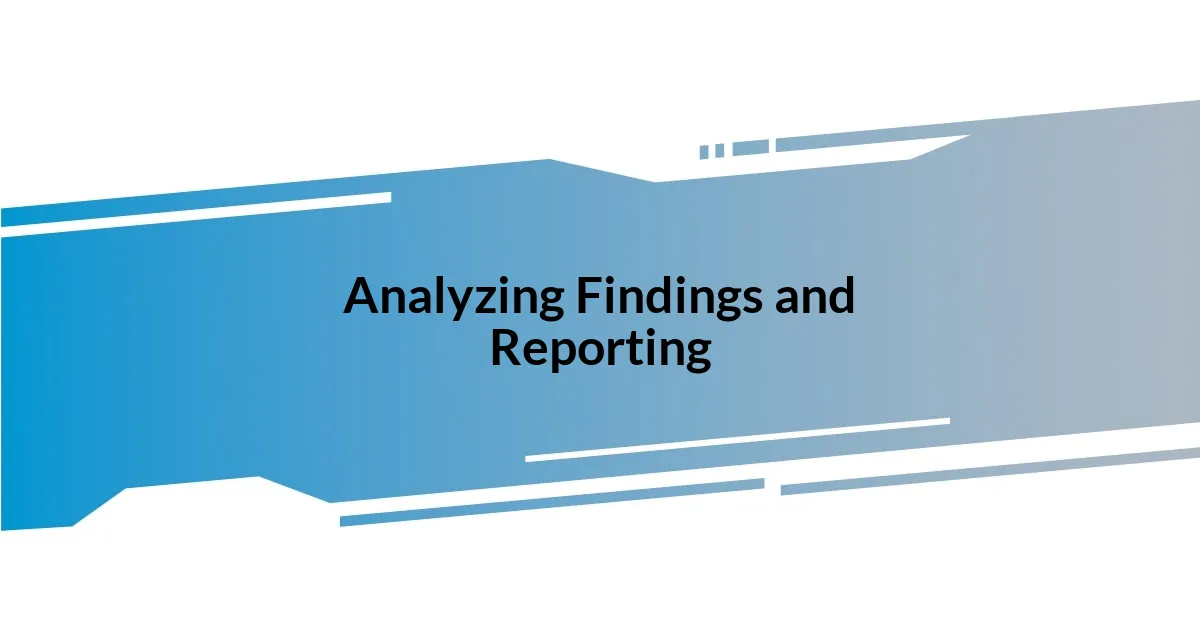
Analyzing Findings and Reporting
Analyzing the findings from a security audit requires a meticulous yet thoughtful approach. I remember a time when I poured over our initial report, feeling a mix of excitement and trepidation. The data was rich, revealing insights that were both concerning and enlightening. By categorizing the findings into themes, I was able to see not just individual issues but also patterns that pointed to larger systemic weaknesses. This holistic view often leads to more impactful recommendations, don’t you think?
When it comes to reporting, clarity is paramount. Crafting a report that resonates with stakeholders is crucial. One particular instance that stands out to me was when I simplified our findings using visuals and straightforward language. The moment I saw the leadership team nodding along, I knew I had struck the right chord. Engaging your audience with a narrative that tells the story behind the data can be incredibly powerful. It’s not just about what we discovered, but why it matters and how we can leverage these insights for improvement.
Finally, follow-up is an essential part of the analysis and reporting process. After distributing the report, I always schedule a session to discuss the findings in detail. I find that addressing questions and encouraging dialogue fosters a sense of ownership among teams. During one of those sessions, I saw genuine enthusiasm when team members brainstormed solutions together. Isn’t it inspiring to watch conversations evolve into actionable change? I believe that turning discoveries into strategies for improvement is ultimately what drives success in security audits.
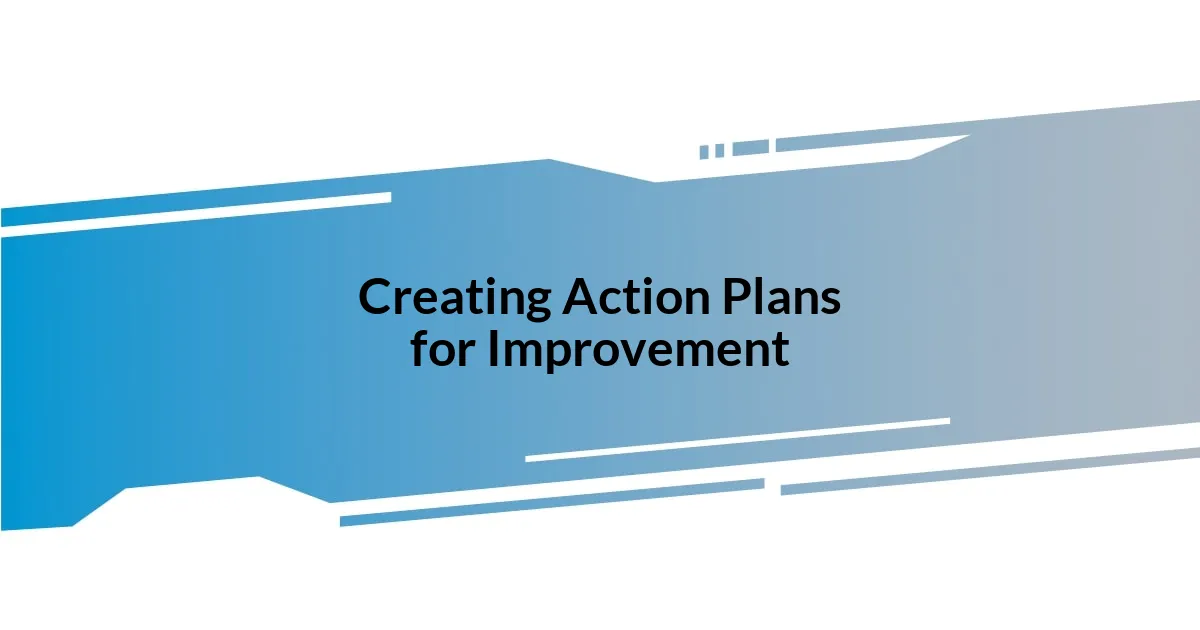
Creating Action Plans for Improvement
Creating actionable plans for improvement after a security audit is where the real transformation begins. I once facilitated a workshop to develop these plans, encouraging team members to share their thoughts openly. The energy in the room was palpable as we broke into small groups, each fueled by a mix of determination and creativity. I found myself thinking, how often do we get the chance to turn vulnerability into strength through collective brainstorming?
Once the ideas began flowing, we documented each suggestion in a structured format that outlined clear responsibilities and timelines. My heart swelled with pride seeing the team talk about ownership over their assigned tasks. It dawned on me that involving everyone not only nurtured a culture of accountability but also sparked a genuine commitment to the collective goal. Isn’t it powerful to witness ambition blossom when people feel included in the process?
Additionally, I always emphasize the importance of measurable outcomes in these action plans. Setting specific benchmarks allows us to track our progress effectively. During one project, we established quarterly reviews to assess our advancements, and the results were illuminating. I remember feeling inspired during our first review, as we celebrated small wins and acknowledged areas still in need of attention. It made me realize that improvement is not just about the destination but also about appreciating the journey along the way. How do we recognize our progress without pausing to see how far we’ve come?